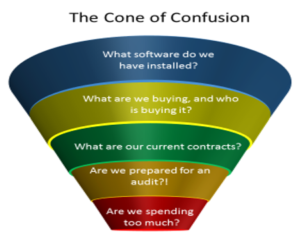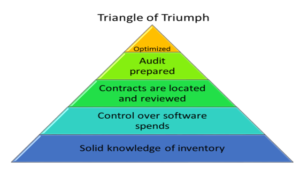Turning Your SAM Cone of Confusion to a Triangle of Triumph
-
January 11, 2017
- Posted by: Scalable Team
In the study of sound, especially sound localization, there is a term called the cone of confusion. Loosely stated, what this refers to is “the region of positons in space where all sounds produce the same time and level (intensity) differences.” In this situation, it is hard for the listener to pinpoint, or locate a sound. Confusion sets in as to where the sound is coming from and one of the individual’s main sensory tools, i.e. hearing, is considerably weakened.
Pilots also refer to the cone of confusion as a situation where a plane flies directly over a radio beacon losing all radio signals thus rendering the course deviation indicator temporarily useless. Once the pilot flies out of this cone of airspace over the radio beacon, all is well again.
What is the SAM Cone of Confusion?
As a SAM analyst, I often see customers caught in what I call a software asset management (SAM) cone of confusion. They don’t “hear” what their IT estate is telling them and they are unsure what direction to take. There are multiple factors contributing to this confusion. It generally begins with not knowing what is owned, or even what is installed. Going with the theme, ‘you can’t manage what you can’t measure’, this situation is one of the most common I see.
Additionally, because they don’t know what they don’t have, control over their IT purchasing is lost. This leads to unnecessary spending. Can you recall a time that your company bought software that they already had, unaware that unused copies were laying shrink wrapped, unopened in storage? Or perhaps, acquired applications for new employees when they already owned ones that were not being used? I know several customers that have. When a business doesn’t know what it has installed, and is blindly purchasing software on an as needed basis, this also leads to a lack of contract/agreement control. Without a centralized location that contains documentation of your legal agreements, what they cover, and when they expire, further chaos is created.
Moving further into the cone of confusion, having poor knowledge of your inventory, uninformed spending and a vague handle on contracts and agreements probably indicates that you are not prepared for a vendor audit. This leads to a host of problems including expensive true ups and/or fines for noncompliance. At the very end of this unpleasant condition, you have inefficiently licensed software. For example, enterprise versions covering installations that only need a standard version. Deluxe, expensive editions are installed where the end user simply needs the read only version. All of the above combine in a perfect storm that can lead to a SAM nightmare. But how does one turn things around? Let’s see…
Emerging from the SAM Cone of Confusion
To begin with, you need to find out what’s out there. Acquiring a good discovery tool with integrated inventory and normalization can be a great start. At Scalable, our discovery is state of the art. We accomplish this not only by using agents, but agentless scans as well. Once you have a grip on your inventory, you can then begin the process of getting your contracts under control. Speaking of contracts, managing them is vital to get the upgrades, patches and maintenance you will need to keep your software assets performing. One of the ways to do this is to put them in a central location where expiration dates and other details can be monitored. Getting a six month notice that a contract is expiring will give you the time you need to go over your inventory and utilization in order to have the best information during a renewal negotiation.
Once you have your inventory and contracts under control, you are best prepared for an audit. Many software publishers have stepped up their audit activity, and according to recent Gartner survey, data over the past six years shows that audit frequency has stabilized, with an average of 68% of survey respondents having received an audit request each year1. Having a clear knowledge of what you own, what contracts are in place, what use rights you have, and how you are actually using the software will go very far in satisfying any audit. This also puts you in a position to have “no surprises.” That means no expensive fines or unplanned purchases as the result of an audit, especially when you are least prepared.
Achieving the Triangle of Triumph
Now that your organization has accomplished all of the above and is audit ready, it is time to move into the more advanced stages of software asset management. In a broad brush stroke, this includes software optimization. One of the ways this can be accomplished is by not paying for software you already have. Another way is to see how much your software is being used.
The Optimize feature in Scalable’s Asset Vision suite of products lets you see which users are using the software and for how long. User’s that are not utilizing the application can have it removed (if the contract allows) and the software can be placed on another machine through reclamation and re-harvesting of licenses. Optimizing your server software, especially those products which are virtualized also has lots of money saving implications. As datacenters change, grow and contract, it is very important to keep up with the proper licensing rules and to make sure you are licensed in the most efficient way. Management of SaaS applications also needs to be properly considered as costs will not go away, just come with another set of management challenges.
All of these situations can have optimal outcomes when you are using an effective SAM solution. Putting together the right people, processes and tools will help you turn your cone of confusion to a triangle of triumph.
________________________________
1 Toolkit: Surviving a Software Audit, Gartner Research note G00293119, February 23, 2016, Analyst(s): Victoria Barber | Ben Jepson | Hank Marquis | Marie Sienkowski

